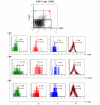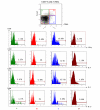Are CD4+CD25-Foxp3+ cells in untreated new-onset lupus patients regulatory T cells?
- PMID: 19821980
- PMCID: PMC2787292
- DOI: 10.1186/ar2829
Are CD4+CD25-Foxp3+ cells in untreated new-onset lupus patients regulatory T cells?
Abstract
Introduction: Our previous study has reported that, in patients with untreated new-onset lupus (UNOL), there was an abnormal increase in the number of CD4+CD25-Foxp3+ T cells that correlated with disease activity and significantly decreased after treatment. However, little is known about the nature of this cell entity. The aim of this study was to explore the nature of abnormally increased CD4+CD25-Foxp3+ T cells in UNOL patients.
Methods: The expressions of surface (CD4, CD25, CD127, chemokine receptor 4 [CCR4], glucocorticoid-induced tumor necrosis factor receptor [GITR], and cytotoxic T lymphocyte-associated antigen 4 [CTLA-4]) and intracellular (Foxp3) molecules as well as cytokine synthesis of peripheral blood mononuclear cells from 22 UNOL patients were analyzed by flow cytometry. The proliferative and suppressive capacities of different T-cell subgroups from UNOL patients were also assessed.
Results: In UNOL patients, the percentages of CD127(low/-) in CD25(high), CD25(low), and CD25- subpopulations of CD4+Foxp3+ T cells were 93.79% +/- 3.48%, 93.66% +/- 2.31%, and 91.98% +/- 2.14%, respectively (P > 0.05), whereas the expressions of Foxp3 showed significant differences in CD25(high) (91.38% +/- 2.57%), CD25(low) (71.89% +/- 3.31%), and CD25- (9.02% +/- 2.21%) subpopulations of CD4+CD127(low/-) T cells (P < 0.01). The expressions of surface CCR4, GITR, and CTLA-4 on CD4+CD25-Foxp3+ T cells were significantly less than CD4+CD25+Foxp3+ T cells (P < 0.05). Moreover, unlike CD4+CD25+Foxp3+ T cells, CD4+CD25-Foxp3+ T cells also synthesized interferon-gamma, interleukin (IL)-4, IL-2, and IL-17 (P < 0.05), though less than CD4+CD25+Foxp3- T cells. The suppressive capacity was most prominent in CD4+CD25(high)CD127(low/-), followed by CD4+CD25(low)CD127(low/-). CD4+CD25-CD127- T cells showed the least suppressive capacity, which was similar to the effector T cells.
Conclusions: CD4+CD25-Foxp3+ T cells in UNOL patients are different from regulatory T cells, both phenotypically and functionally. CD127 is not an appropriate surface marker for intracellular Foxp3 in CD4+CD25- T cells.
Figures





Comment in
-
Identity of mysterious CD4+CD25-Foxp3+ cells in SLE.Arthritis Res Ther. 2010;12(1):101. doi: 10.1186/ar2894. Epub 2010 Jan 20. Arthritis Res Ther. 2010. PMID: 20122288 Free PMC article. Review.
References
Publication types
MeSH terms
Substances
LinkOut - more resources
Full Text Sources
Medical
Research Materials

